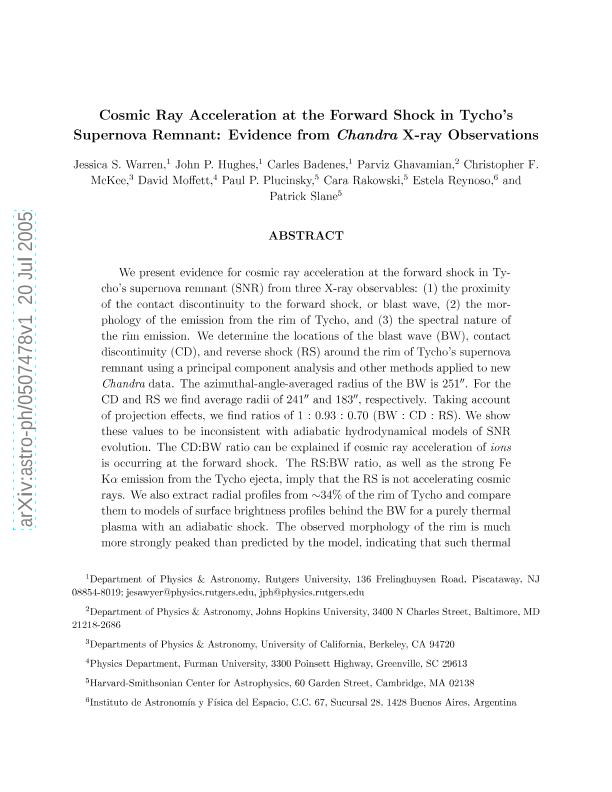Mostrar el registro sencillo del ítem
dc.contributor.author
Warren, Jessica S.
dc.contributor.author
Hughes, John P.
dc.contributor.author
Badenes, Carles
dc.contributor.author
Ghavamian, Parviz
dc.contributor.author
McKee, Christopher F.
dc.contributor.author
Moffett, David A.
dc.contributor.author
Plucinsky, Paul P.
dc.contributor.author
Rakowski, Cara
dc.contributor.author
Reynoso, Estela Marta

dc.contributor.author
Slane, Patrick
dc.date.available
2017-07-20T19:00:59Z
dc.date.issued
2005-12
dc.identifier.citation
Warren, Jessica S.; Hughes, John P.; Badenes, Carles; Ghavamian, Parviz; McKee, Christopher F.; et al.; Cosmic-Ray Acceleration at the Forward Shock in Tycho's Supernova Remnant: Evidence from Chandra X-Ray Observations; IOP Publishing; Astrophysical Journal; 634; 1; 12-2005; 376-389
dc.identifier.issn
0004-637X
dc.identifier.uri
http://hdl.handle.net/11336/21009
dc.description.abstract
We present evidence for cosmic-ray acceleration at the forward shock in Tycho's supernova remnant (SNR) from three X-ray observables: (1) the proximity of the contact discontinuity to the forward shock, or blast wave, (2) the morphology of the emission from the rim of Tycho, and (3) the spectral nature of the rim emission. We determine the locations of the blast wave (BW), contact discontinuity (CD), and reverse shock (RS) around the rim of Tycho's supernova remnant using a principal component analysis and other methods applied to new Chandra data. The azimuthal-angle-averaged radius of the BW is 251". For the CD and RS we find average radii of 241" and 183", respectively. Taking account of projection effects, we find ratios of 1:0.93:0.70 (BW:CD:RS). We show these values to be inconsistent with adiabatic hydrodynamic models of SNR evolution. The CD:BW ratio can be explained if cosmic-ray acceleration of ions is occurring at the forward shock. The RS:BW ratio, as well as the strong Fe Kalpha emission from the Tycho ejecta, imply that the RS is not accelerating cosmic rays. We also extract radial profiles from ~34% of the rim of Tycho and compare them to models of surface brightness profiles behind the BW for a purely thermal plasma with an adiabatic shock. The observed morphology of the rim is much more strongly peaked than predicted by the model, indicating that such thermal emission is implausible here. Spectral analysis also implies that the rim emission is nonthermal in nature, lending further support to the idea that Tycho's forward shock is accelerating cosmic rays.
dc.format
application/pdf
dc.language.iso
eng
dc.publisher
IOP Publishing

dc.rights
info:eu-repo/semantics/openAccess
dc.rights.uri
https://creativecommons.org/licenses/by-nc-sa/2.5/ar/
dc.subject
Supernova
dc.subject.classification
Astronomía

dc.subject.classification
Ciencias Físicas

dc.subject.classification
CIENCIAS NATURALES Y EXACTAS

dc.title
Cosmic-Ray Acceleration at the Forward Shock in Tycho's Supernova Remnant: Evidence from Chandra X-Ray Observations
dc.type
info:eu-repo/semantics/article
dc.type
info:ar-repo/semantics/artículo
dc.type
info:eu-repo/semantics/publishedVersion
dc.date.updated
2017-07-20T13:08:05Z
dc.journal.volume
634
dc.journal.number
1
dc.journal.pagination
376-389
dc.journal.pais
Reino Unido

dc.journal.ciudad
Londres
dc.description.fil
Fil: Warren, Jessica S.. Rutgers University; Estados Unidos
dc.description.fil
Fil: Hughes, John P.. Rutgers University; Estados Unidos
dc.description.fil
Fil: Badenes, Carles. Rutgers University; Estados Unidos
dc.description.fil
Fil: Ghavamian, Parviz. University Johns Hopkins; Estados Unidos
dc.description.fil
Fil: McKee, Christopher F.. University of California; Estados Unidos
dc.description.fil
Fil: Moffett, David A.. Furman University; Estados Unidos
dc.description.fil
Fil: Plucinsky, Paul P.. Harvard-Smithsonian Center for Astrophysics; Estados Unidos
dc.description.fil
Fil: Rakowski, Cara. Harvard-Smithsonian Center for Astrophysics; Estados Unidos
dc.description.fil
Fil: Reynoso, Estela Marta. Consejo Nacional de Investigaciónes Científicas y Técnicas. Oficina de Coordinación Administrativa Ciudad Universitaria. Instituto de Astronomía y Física del Espacio. - Universidad de Buenos Aires. Facultad de Ciencias Exactas y Naturales. Instituto de Astronomía y Física del Espacio; Argentina
dc.description.fil
Fil: Slane, Patrick. Harvard-Smithsonian Center for Astrophysics; Estados Unidos
dc.journal.title
Astrophysical Journal

dc.relation.alternativeid
info:eu-repo/semantics/altIdentifier/url/https://arxiv.org/abs/astro-ph/0507478
dc.relation.alternativeid
info:eu-repo/semantics/altIdentifier/url/http://iopscience.iop.org/article/10.1086/496941
dc.relation.alternativeid
info:eu-repo/semantics/altIdentifier/doi/http://dx.doi.org/10.1086/496941
Archivos asociados
